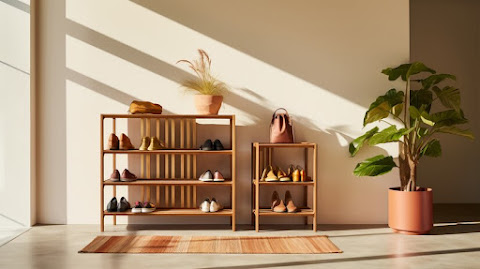A well-organized closet is essential for maintaining a tidy home, and the right shelving plays a crucial role in achieving this. When selecting materials for closet shelves, it’s important to consider factors such as durability, aesthetics, budget, and the specific needs of the items you plan to store. This article will guide you through the process of choosing the best materials for your closet shelves, ensuring that your investment is both functional and stylish.
1. Assess Your Needs
Before diving into material options, it’s essential to assess what you’ll be storing on your shelves. Different materials have varying load capacities, so understanding your needs Closets Creation Inc. will help you choose the right one.
Heavy Items: If you plan to store heavy items like books, storage bins, or shoes, you’ll need strong and sturdy shelving materials.
Light Items: For lighter items like clothes or accessories, you can opt for less heavy-duty materials.
Aesthetic Considerations: Consider whether you want the shelves to match the existing decor or if they will be concealed behind closet doors.
2. Wood and Wood-Based Materials
Wood and wood-based materials are popular choices for closet shelves due to their versatility, strength, and aesthetic appeal.
Solid Wood: Solid wood is a durable and visually appealing option that can hold a significant amount of weight. Woods like oak, maple, and pine are common choices. While solid wood can be more expensive, it offers a timeless look and can be stained or painted to match your decor.
Pros: High durability, customizable finish, strong load capacity.
Cons: Higher cost, susceptible to warping in humid environments.
Plywood: Plywood is a more affordable alternative to solid wood. It’s made by layering thin sheets of wood veneer, which makes it stable and resistant to warping. Plywood is often used for custom shelving projects because it can be easily cut to size and finished with veneers or paint.
Pros: Cost-effective, stable, versatile.
Cons: Less durable than solid wood, edges need to be finished for a polished look.
MDF (Medium-Density Fiberboard): MDF is an engineered wood product made from wood fibers and resin. It’s a budget-friendly option that offers a smooth surface, making it easy to paint. However, MDF is not as strong as solid wood or plywood, so it’s best used for lighter loads.
Pros: Affordable, smooth finish, easy to paint.
Cons: Lower strength, susceptible to damage from moisture.
Particleboard: Particleboard is another engineered wood product made from wood chips and resin. It’s the least expensive option but also the least durable. Particleboard is often used for pre-fabricated shelving but is not recommended for heavy items or humid environments.
Pros: Very affordable, lightweight.
Cons: Low durability, prone to sagging and moisture damage.
3. Metal Shelving
Metal shelves are known for their strength and durability. They are an excellent choice for closets that need to support heavy loads, such as in a garage or pantry.
Steel Shelves: Steel shelves are extremely durable and can support a significant amount of weight. They’re often used in industrial settings but can be adapted for home use with the right finish. Steel shelves can be powder-coated in various colors to match your decor.
Pros: High strength, long-lasting, resistant to warping and sagging.
Cons: Can be more expensive, may have a utilitarian look.
Wire Shelving: Wire shelving is a popular option for closets due to its affordability, ease of installation, and ventilation. It’s particularly useful in areas where air circulation is important, such as linen closets.
Pros: Affordable, easy to install, allows air circulation.
Cons: May not support heavy loads, less aesthetically pleasing.
4. Glass Shelving
Glass shelves offer a sleek and modern look, making them a great option for displaying items in a walk-in closet or dressing room. However, they are best suited for light to medium-weight items.
Tempered Glass: Tempered glass is the recommended choice for shelves, as it is stronger and safer than regular glass. It can be custom-cut to fit your space and is available in various thicknesses.
Pros: Modern aesthetic, easy to clean, reflective surface enhances light.
Cons: Can be expensive, may require professional installation, prone to fingerprints and smudges.
5. Laminate Shelving
Laminate shelving consists of a particleboard or MDF core with a laminated surface. It’s a budget-friendly option that mimics the look of wood, stone, or other materials. Laminate shelves are easy to clean and available in a wide range of colors and patterns.
Pros: Affordable, easy to clean, variety of styles.
Cons: Less durable than solid wood or metal, edges can peel over time.
6. Aesthetic Considerations
Your choice of material should align with the overall design and decor of your space. Consider the following:
Color and Finish: Wood and laminate shelves offer various finishes, from natural wood tones to bold colors, allowing you to match your shelves with your room's decor.
Style: Metal and glass shelves tend to have a more modern, industrial look, while wood provides a warmer, traditional feel.
7. Budget and Installation
Finally, consider your budget and whether you’ll be installing the shelves yourself or hiring a professional.
DIY Installation: If you’re planning to install the shelves yourself, choose materials that are easy to work with, like pre-finished wood or wire shelving.
Professional Installation: For custom designs or materials like glass or metal, professional installation may be necessary, which will add to the overall cost.
Conclusion
Choosing the right materials for your closet shelves is a critical decision that affects both the functionality and aesthetics of your space. By assessing your storage needs, considering the pros and cons of each material, and keeping your budget in mind, you can select the perfect shelving solution that meets your requirements and enhances your closet's overall design. Whether you opt for the timeless appeal of solid wood, the modern look of metal, or the budget-friendly options of MDF and laminate, your closet will be well-equipped to serve your storage needs for years to come.









